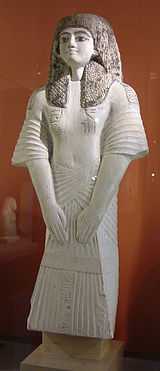Arms-in-embrace (hieroglyph)
| |||||
| Arms-in-Embrace in hieroglyphs |
|---|

Ring honoring Khufu, (Cheops), Ptolemaic Period.
The ancient Egyptian Arms-in-embrace hieroglyph, Gardiner sign listed no. D32 is a portrayal of the embracing human arms. The hieroglyph is in the large Gardiner sign list category of Parts of the Human Body.
Multiple types of additional hieroglyphs are inserted between the arms, forming Gardiner unlisted varieties.
Usage
The Egyptian language arms-in-embrace hieroglyph has multiple uses. It is a determinative for 'hugging', inq, "to surround", and ḥpt, "to hug".
As an ideogram it has two meanings for s(kh)n. Both uses are verb uses. 'Sekhen-1', with multiple spellings, and various secondary determinatives,
(sḫn),[1] meaning: to fold in the arms, to embrace, to contain, to hold. The second meaning, (sḫn), spellings of,
is used to mean: to happen, a happening, event, occurrence. (verb or noun).
|
|
In the 196 BC Rosetta Stone, a Good Forture phrase is a segue to the 8 listed rewards given to the honoring of Ptolemy V, one, by erecting his Decree of Memphis (Ptolemy V) in the temple courtyard. The phrase is three-part: ḥ' s(kh)n nfr, And a happening good ! – [may there be]'.[2]
|
Preceded by
Sistrum -- -- s(kh)m |
arms-in-embrace -- -- s(kh)n |
Succeeded by
support -- -- s(kh)n-t |
Gallery
-

Slab stela, multiple use of the "arms-in-embrace" for supplying provisions for the Afterlife
-

Statuary use of the hieroglyph
See also
| Wikimedia Commons has media related to Category:Arms-in-embrace (hieroglyph). |
- Gardiner's Sign List#O. Parts of the Human Body
References
- Budge, 1978, (1920). An Egyptian Hieroglyphic Dictionary, E.A.Wallace Budge, (Dover Publications), c 1978, (c 1920), Dover edition, 1978. (In two volumes, 1314 pp, and cliv-(154) pp.) (softcover, ISBN 0-486-23615-3)
- Budge, 1989, (1929). The Rosetta Stone, E.A.Wallace Budge, (Dover Publications), c 1929, Dover edition(unabridged), 1989. (softcover, ISBN 0-486-26163-8)